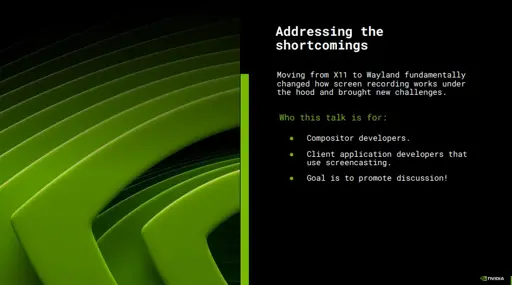In addition to showing the need for unifying DRM driver-side APIs within the Linux kernel, NVIDIA’s Linux graphics driver team at XDC2025 also showcased the shortcomings of screencasting under Wayland.
Doğukan Korkmaztürk of NVIDIA presented on the issues that persist with screencasting under Wayland from both the compositor and client perspectives. From the state of explicit synchronization to performance differences compared to X11, there are some pain points that ultimately still need to be addressed for a better screen casting/capturing experience on Wayland.



Not learning from the past means repeating the same mistakes. I see little evidence that NVidia’s overall approach changed. It’s always that everyone has to adapt to their way of doing things and rarely that NVidia seek collaboration first. That’s why it has taken years and three entirely different memory management technologies.
With NVidia it’s always “This is the last piece of technology and then everything will be perfect.” ExplicitSync is only the latest episode. Now that ExplicitSync is there, compatibility on Linux is still a crapshoot with NVidia.
Where is the closed source user space of Intel and AMD drivers? It doesn’t exist because they use Mesa for the best possible compatibility. NVidia don’t. I’ve read comments by people bashing the recent Baldur’s Gate 3 Linux release and being full of graphics glitches. Then they list their hardware as proof how great it is and they all have NVidia GPUs.
They’re not in user space, they’re in the firmware of the GPUs. It’s embedded in some chip somewhere on the card or in the motherboard. The open source components communicate with that closed part.
Nvidia previously implemented nearly everything in their nonfree kernel module driver. Today, they’ve pushed enough of the parts they’re protective of into the firmware, so that they can release the kernel module as open source/GPL.
Mesa is just the userspace implementation of higher level graphics APIs like OpenGL or Vulkan, which communicate with the underlying drivers. I actually think its a good thing the Nvidia has their own implementation of this as it creates competition, and they’re positioned to improve consistency across windows/Linux since they likely reuse a lot of code on both platforms.
That’s Larian’s fault for releasing a buggy port. They probably only tested on AMD because they only care about the Steam Deck on Linux. GPU drivers are always buggy, even on windows. The only way to ensure compatibility is to spend the time and effort to test on all of them.